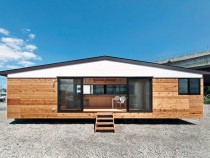
© Atelier Tekuto
Prompted by the situation after the earthquakes in Japan, a concept was drawn up to help victims return to permanent homes. The architects’ solution was to create well designed, low-cost mobile houses that would be quickly available and that would have a life of at least 30 years. The form of construction means that the houses can be simply assembled and dismantled and are adaptable. Fabricated in a central location, they can be erected as temporary dwellings on an unaffected site while the infrastructure is being restored. Later, they can be transported to a familiar environment and set on solid foundations as permanent homes. Different forms of construction allow the houses to be adapted to various needs: they can be used as mobile clinics, as multi-purpose spaces and as sanitary facilities for voluntary-aid workers. All types are based on the same principles: a pitched roof to convey a sense of security; the use of solid timber internally and externally; good natural air circulation; maximum daylighting; a large, high living space (roughly 40 m2); and an insulated outer skin. After the tsunami catastrophe in 2011, the government refused permission for the erection of new buildings in many affected areas. Nevertheless, voluntary-aid workers need accommodation. The architects therefore suggest the use of a “mobile smile” building in the form of a transportable emergency hotel.







